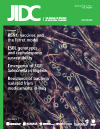Quorum sensing and virulence of Pseudomonas aeruginosa during urinary tract infections
DOI:
https://doi.org/10.3855/jidc.2543Keywords:
P. aeruginosa, quorum sensing, virulence factorsAbstract
Introduction: In the opportunistic pathogen Pseudomonas aeruginosa, the production of several virulence factors depends on quorum sensing (QS) involving N-acylhomoserine lactone signal molecules. In vitro studies have suggested that the QS system is crucial in the pathogenesis of P. aeruginosa. However, it is unclear whether QS systems of P. aeruginosa play the same role during infections.
Methodology: In this study, to explore the contribution of QS systems to the pathogenesis of P. aeruginosa during urinary tract infections, we collected 82 clinical isolates. Detection of N-acyl-homoserine lactones (C12-HSL and C4-HSL) was performed on agar plates employing biosensor strains C. violaceum. Elastase and biofilm production were determined spectrophotometrically. QS genes were detected by PCR and subsequently underwent sequencing.
Results and conclusion: Six isolates were found to be negative in the production of both C12-HSL and C4-HSL and all virulence factors tested. PCR analysis of these isolates revealed that four isolates contained all four QS genes while one isolate was negative for lasR gene, and one isolate negative for lasI, lasR and rhlR genes. Sequence analyses of these isolates showed that the lasR, lasI, rhlR and rhlI genes had point mutations. The combination of these mutations probably explains their C12-HSL, C4-HSL and virulence factor deficiencies. Results of this study suggest that QS deficient clinical isolates occur and are still capable of causing clinical infections in humans.
Downloads
Published
How to Cite
Issue
Section
License
Authors who publish with this journal agree to the following terms:
- Authors retain copyright and grant the journal right of first publication with the work simultaneously licensed under a Creative Commons Attribution License that allows others to share the work with an acknowledgement of the work's authorship and initial publication in this journal.
- Authors are able to enter into separate, additional contractual arrangements for the non-exclusive distribution of the journal's published version of the work (e.g., post it to an institutional repository or publish it in a book), with an acknowledgement of its initial publication in this journal.
- Authors are permitted and encouraged to post their work online (e.g., in institutional repositories or on their website) prior to and during the submission process, as it can lead to productive exchanges, as well as earlier and greater citation of published work (See The Effect of Open Access).








